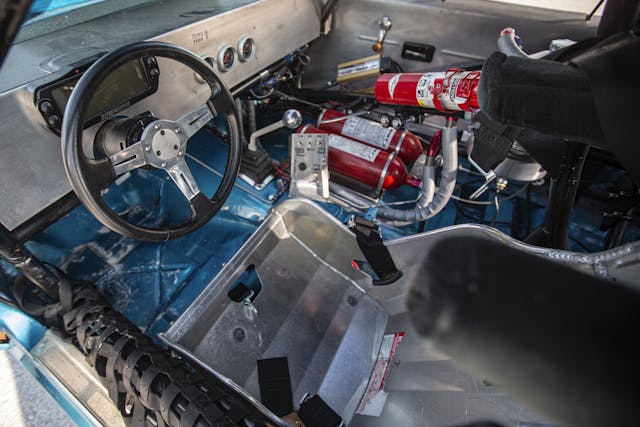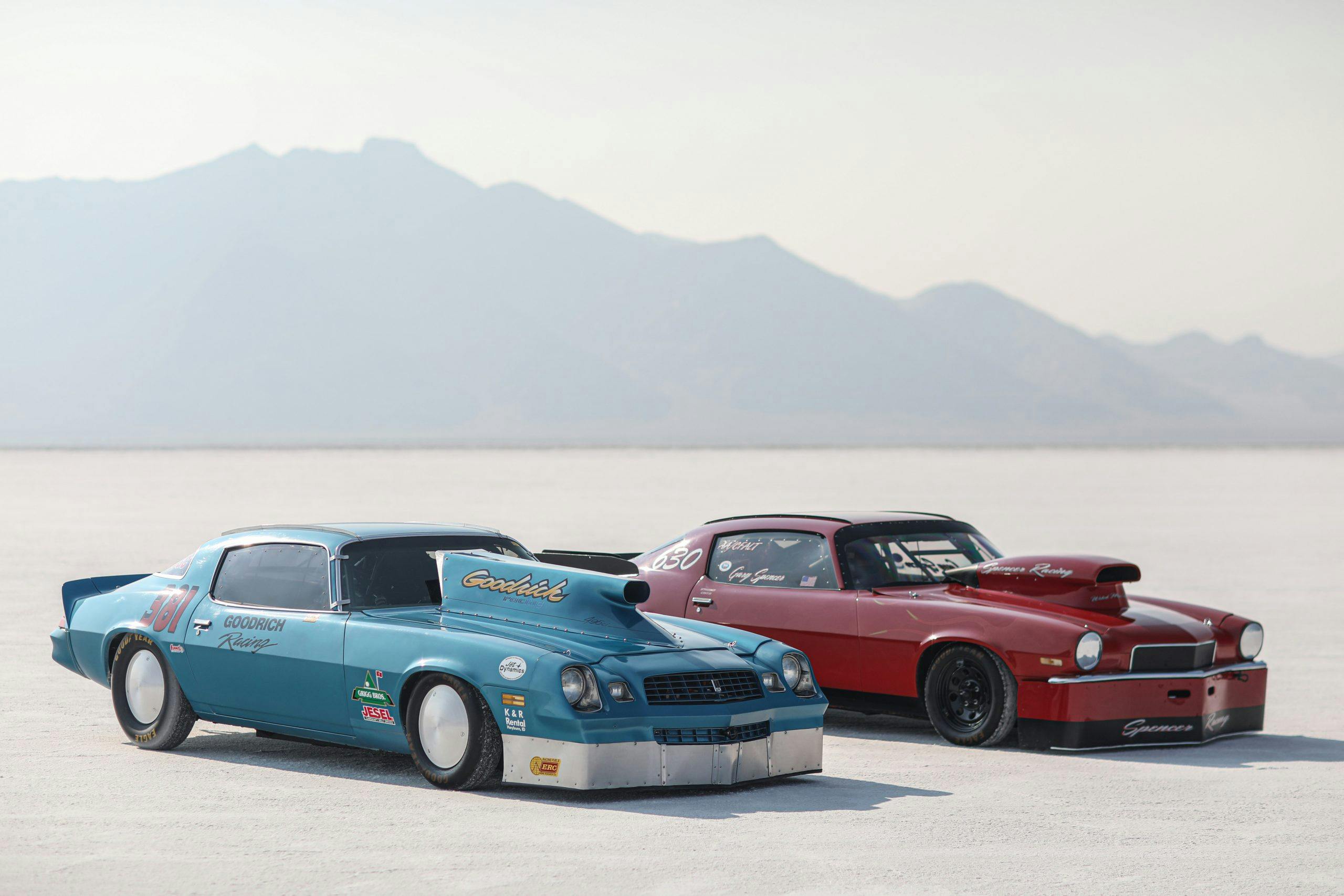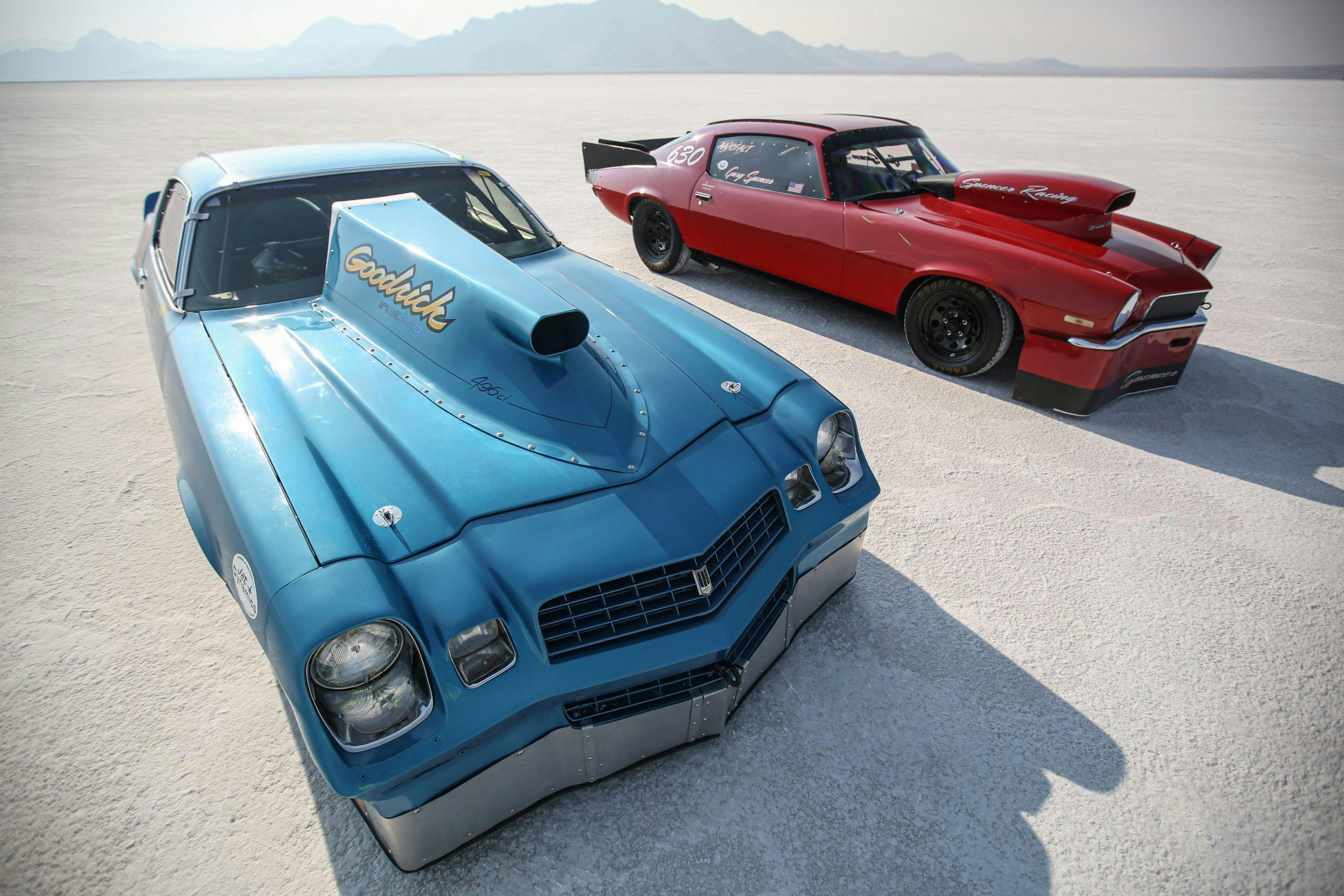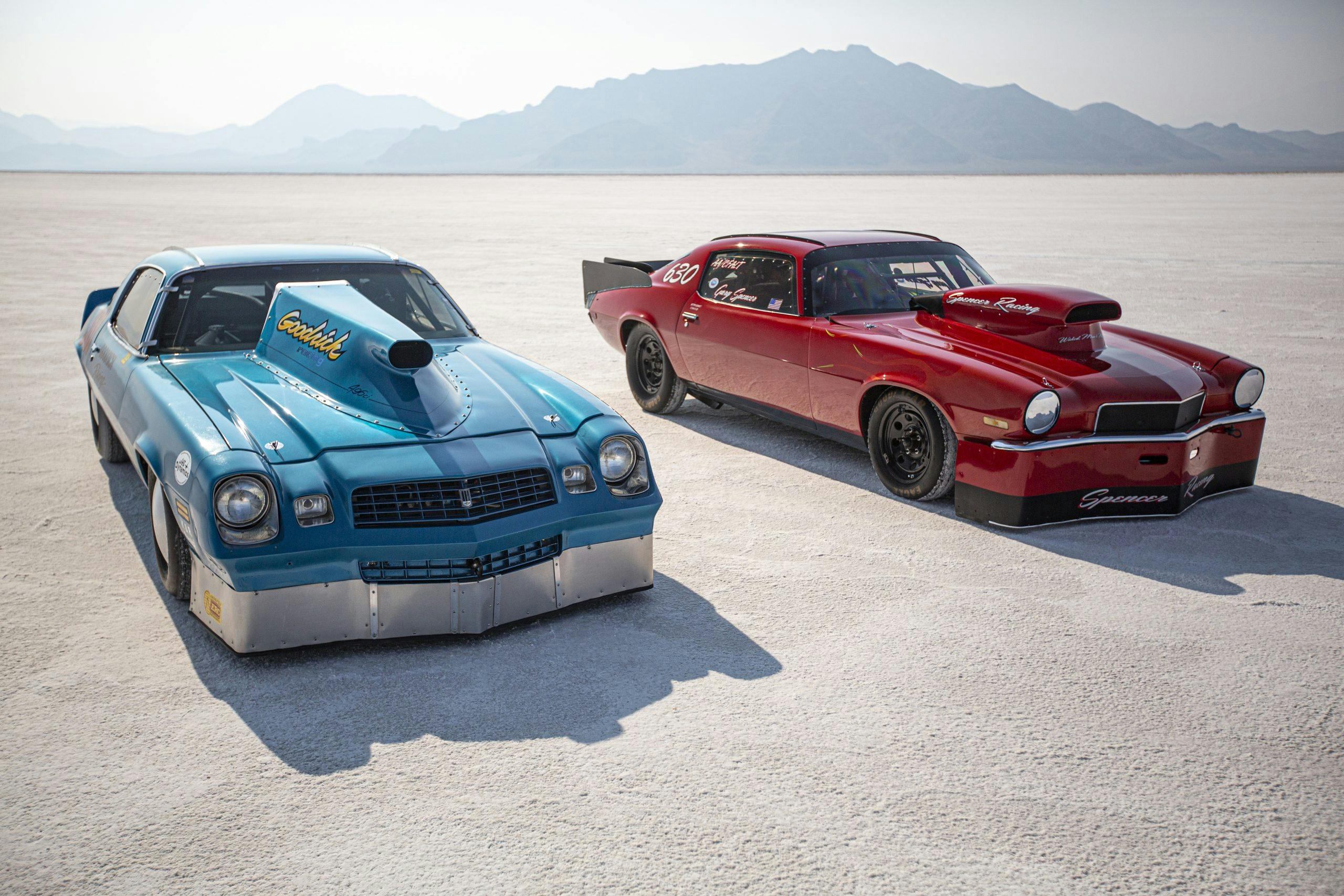Media | Articles
Camaro Two Ways: Second-gens tackle the salt with big-block power
We’ve often commented here at Hagerty that Bonneville Speed Week brings out all sorts of strange and unique cars, but a few body styles tend to pop up on the salt flats with some regularity. Early Ford coupes and roadsters are practically part of the landscape, and sleek Studebaker coupes are also a racer favorite. One more body style that keeps showing up: the second-generation F-body. Whether it’s in Camaro or Firebird guise, the long-hood, short-deck design of the ’70-’81 GM pony cars is becoming a Bonneville staple. When we spotted two pitted together, we had to stop and see what’s bringing F-body owners to the salt year after year.
Gary Spencer’s 1971 Camaro
Gary Spencer has spent, all told, nearly a year of his life on the Bonneville salt. His father brought him to his first Speed Week 60 years ago, and once he was old enough, he helped his dad run a Studebaker and then a lakester. He even got behind the wheel of a few different cars before he decided to build a car of his own. Spencer had previously owned a 1971 Camaro, which he purchased new in 1970, so he began his search for an early second-gen Camaro. The one he found, this one, was a former southern California drag car, and appropriately enough, it was advertised for sale in National Dragster. He met the seller in Las Vegas and towed it home to his shop near Salt Lake City, where he and crew chief Pat Christiansen began its transformation to land speed racer.

We asked what it was about the Camaro that lead Spencer to choose one for his land speed racing. Aside from his fondness for the car’s looks, it was also a matter of practicality. “There are probably more aerodynamic cars, but they came with big-block engines from the factory, so you can run that engine in the class.” Spencer explained. Barring a slippery profile, you’ll need a lot of brute force to push a car well past 200 mph, and there’s no shortage of power (mostly) under the hood of Spencer’s Camaro.

The big-block in Spencer’s car is indeed a big specimen. It displaces 582 cubic inches by way of a 4.6-inch bore and 4.375-inch stroke. It’s about as big as you can go with a standard deck height Chevy big-block and would make one heck of a sleeper if you were to drop one in your street car and convince everyone it was a 396. Of course, there’s no fooling anyone with this mill, given the Profiler tunnel ram with twin Holley Dominator carbs perched on top and the 2.25-inch primary tubes on the Lemons headers. You just don’t need that kind of airflow to feed your average 600-hp street engine. The bottom end of the brutal big-block is made up of a Crower crank and rods and Mahle pistons. A set of Brodix BB3 heads allows for serious airflow and the huge valves are actuated by a Sig-Erson roller cam. The engine was ported and assembled by Fastlane Machine in Orem, Utah. Fastlane also did some dyno testing and the engine produces just over 1100 hp on VP C14 race gas.
Spencer has used big-blocks to set three records which he currently holds: the AA Classic Gas Altered record at 246.441 mph, the A Classic Fuel Altered record at 250.704 mph, and the AA Classic Fuel Altered record at 259.110 mph. This year, Spencer was trying to increase his AA Classic Gas Altered record and had a couple of new tricks with the engine to squeeze out a few extra ponies, but the engine suffered a setback on its break-in run. The #5 piston scuffed the cylinder wall and put an end to Spencer’s Speed Week, but he felt that the conditions were right.
Marketplace
Buy and sell classics with confidence

Because the car runs in an “altered” class, Spencer was allowed to cover the headlights and add a rear spoiler. Basing the general design on other cars in the class, Spencer build and tested some aero mods, but it got a little bit twitchy at 240 mph. “A lot of people think you get in those cars and don’t have to drive because you’re going straight, but you’re pretty busy,” he told us. A trip to the Darko Technologies wind tunnel in Ogden, Utah and some help from land speed racer Tom Burkland showed the team that they were close, but a few adjustments dialed everything in. Besides the aero mods, the car also has strategically placed ballast including lead plates in the nose of the car and low in the body. The factory fuel tank is also filled with cement. The total weight is 4200 pounds.
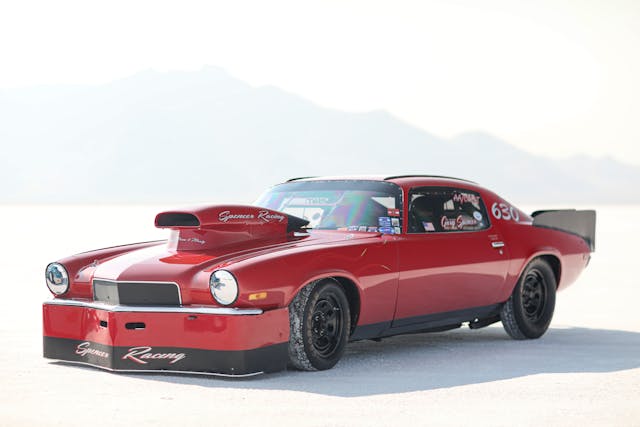
Hopefully next year the salt will hold out and Spencer can increase his record: “I want to have three records with the car over 250.” If he’s able to meet his goal, there’s also the fuel class to tackle, which Spencer plans to do by adding a shot of nitrous oxide. “When we run nitrous, we use it the last two miles. We found that it has a sweet spot with nitrous, too much and it spins the tires,” Spencer said. The right amount for the car seems to be 200 hp.
Ed Goodrich’s 1979 Camaro

After racing in various land speed cars, including a Fox-body Mustang, Goodrich had an itch to build a car of his own. Once word got out that he was in search of a proper project, this Camaro found him. Abandoned in a field and covered in a coat of primer, the car was far from pretty but it had potential. Its interior was rough but the body was rust-free. “It was a good candidate for a Bonneville car,” Goodrich noted. He brought the car home with him to Twin Falls, Idaho, and began the conversion to race car by stripping out the remaining interior and sagging headliner and fabricating a roll cage according to the SCTA’s rule book. “I’ve learned a lot since then,” Goodrich told us. As such, he’s revamped the cage to strengthen the car, but most of the original tubing remains. The striking metallic blue paint was shot in his own garage.
When Ed and Maggie Goodrich showed up at Bonneville to take on the A/Classic Gas Coupe record in this bright metallic blue Camaro, it didn’t take long for Gary Spencer to spot them. That was more than 15 years ago, and the two racing teams have kept up with each others’ progress ever since.
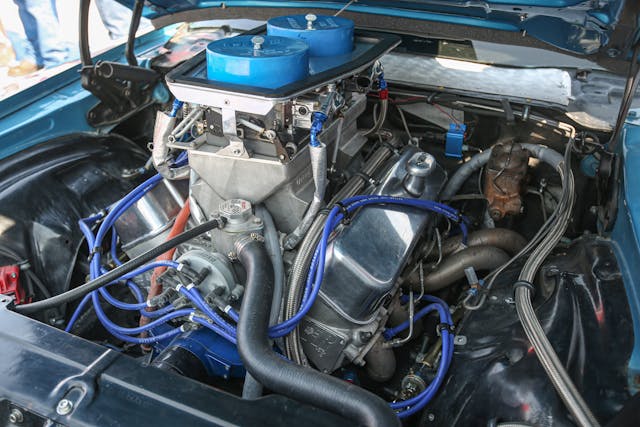
When Goodrich first began competing in his Camaro he used a 454 big-block Chevy, but he upped the power substantially starting in 2003 when he switched to a 496 cubic inch version of Chevy’s rat motor. The bottom end of the engine uses a Dart block for the foundation and swings Diamond pistons and Oliver rods. Up top is a set of custom ported AFR heads from Straub Technologies, a Dart tunnel ram, and a pair of Holley carbs. Electronic fuel injection isn’t allowed in the SCTA’s classic land speed racing classes, so Goodrich tinkered with Enderle mechanical fuel injection for a while but has had good results with this simple combination. It produces 915 hp at 7300 rpm, and he shifts shortly after. A five-speed Tremec trans is linked to the big-block with a McLeod clutch and sends power to a Ford nine-inch rear axle. With the current gearing, a 2.71:1 ring and pinion, Goodrich doesn’t use fifth gear.
Goodrich has come tantalizingly close to the record, with a 236.270-mph timeslip against a 237.280-mph Classic Gas Coupe record that dates to 2004. This year at Speed Week he, like Spencer, suffered engine damage. He was running in excess of 233 mph and threw a rod. He thinks he may have over-revved the engine, but without any data acquisition on the car, there’s no way to tell. “It didn’t feel like I lost traction,” he reported.

Keeping the Camaro stable at speeds in excess of 230 mph are a simple aluminum air dam that follows the contours of the front bumper and a whole lot of ballast. Subframe connectors under the car are filled with lead, and the factory fuel tank is filled with water. The total weight of the car, with Goodrich strapped in, is 4450 pounds. “It handles really well. It follows the ruts a little bit. The only issue is if there’s a gust of wind.”

Goodrich has plans to use his digital dash to its full potential and record more data the next time he returns to the salt. That includes exhaust gas temp, O2 sensors, wheel speed, crankcase vacuum, and intake air tempt. He feels like he’s closing in on the record that has eluded him for so long. “I’m gonna try to duplicate everything I had. I think I had the right combination.”
If you visit Bonneville Speed Week next year, look for this pair of 200-mph Camaros to once again be pitted together. They’ll be hitting the long course, hopefully stronger, and smarter, than ever.




